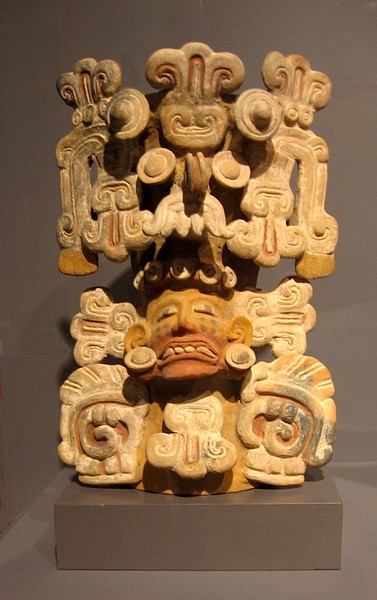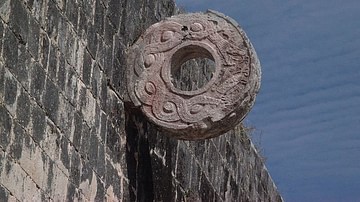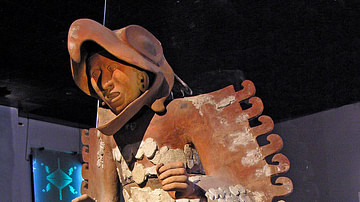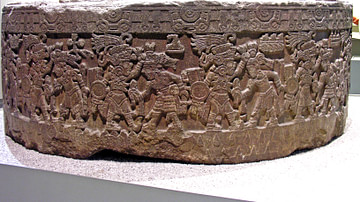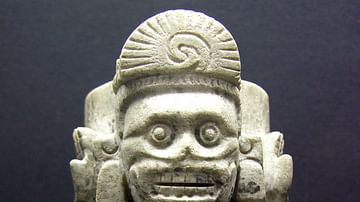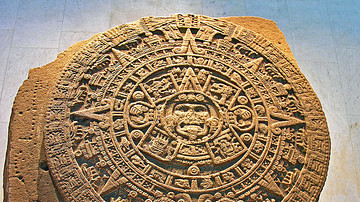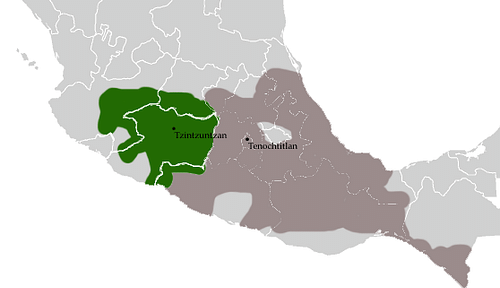
The Tarascan Civilization (aka the Purépecha, after their language) dominated western Mexico and built an empire that would bring it into direct conflict with that other great Mesoamerican civilization of the Post-classic period, the Aztecs. The Tarascan state, with its capital at Tzintzúntzan on Lake Pátzcuaro, controlled an empire of over 75,000 square kilometres, second in size only to the Aztec empire.
Cultural Origins
The history of the Tarascan civilization has been pieced together from the archaeological record and local oral tradition, principally those related in the Relación de Michoacán written by the Franciscan friar Jeronimo de Alcala in the mid-16th century CE. Whilst the Tarascans owed a cultural debt to the earlier Bajio and Michoacán tribal civilizations, the Purépecha culture in fact had a history of over two millennia. The Tarascans were based in the central and northern Michoacán (meaning 'place of the fish masters') around the lake basins of Zacapu, Cuitzeo and Pátzcuaro (modern western Mexico). From as early as the Late Pre-classic period (150 BCE - 350 CE), Purépecha society developed into a more sophisticated culture with a high degree of political centralisation and social stratification by the Middle Post-classic period (1000/1100-1350 CE). According to the Relación the most important tribe were the Wakúsecha (from the Chichimec ethnic group), whose chief Taríakuri established the first capital at Pátzcuaro around 1325 CE.
The territory controlled by the Tarascan state was now double the extent of previous generations and the production and trade of maize, obsidian, basalt and pottery correspondingly increased. The rising level of the lake in the Pátzcuaro basin also meant many low-lying sites were abandoned and the competition for resources became ever more fierce. So too, in the higher lands of the Zacapu, population concentration greatly increased so that 20,000 people inhabited just 13 sites. This period was marked by an increase in local state rivalries and a general instability amongst the ruling elite but the foundations of the great Tarascan empire were now in place.
Tzintzúntzan
From the late Post-classic period (1350-1520 CE, also known as the Tariacuri phase in this context) the Tarascan capital and largest settlement was at Tzintzúntzan on the northeast arm of Lake Pátzcuaro. The Tarascans also controlled, through a highly centralised and hierarchical political system, some 90 plus cities around the Lake. By 1522 CE the population of the basin was as high as 80,000, whilst Tzintzúntzan boasted a population of 35,000. The capital was the administrative, commercial, and religious centre of the Tarascan empire and seat of the king or Kasonsí. Extensive irrigation and terracing projects were carried out in order to make such a large population sustainable on local agriculture but significant imports of goods and material remained a necessity.
A network of local markets and a system of tributes ensured there was a sufficient quantity of basic goods but there was also a ready supply of pottery, shells and metals (particularly gold and silver ingots), and also labour, to meet demand. At these busy marketplaces fruit, vegetables, flowers, tobacco, prepared food, craft goods, and raw materials such as obsidian, copper, and bronze alloys were bought and sold. The state controlled the mining and smelting of silver and gold (in the Balsas Basin and Jalisco), and the production of goods made from these precious materials came via skilled craftsmen who probably resided in the palace complex of Tzintzúntzan. There is some evidence of independent gold and silver production in the south-east and western regions, compatible with evidence of secondary and tertiary administrative centres. In addition, the Tarascans imported turquoise, rock crystal, and green stones whilst from local tribute they acquired cotton, cacao, salt and exotic feathers. The Tarascans were themselves the most important producers of tin-bronze, copper and copper-alloy bells (used in ceremonial dances) in Mesoamerica.
The Tarascan state also controlled land allocation, copper and obsidian mines, forests, the fishing industry and craft workshops in general. However, the degree of control is unclear and local communities and traditional tribal leaders may well have granted royal access to these resources. These diverse ethnic groups within the empire, although subject politically to Tzintzúntzan, also maintained their own language and local identities but in times of war their regular tribute to their Tarascan overlords was augmented by the supply of warriors.
According to the Relación de Michoacán the Tarascan nobility was divided into three groups: royalty, upper and lower nobility (the Wakúsecha elite). Royalty resided at the capital and the sacred site of Ihuátzio, which in fact had been the previous Tarascan capital. The funeral of one Tarascan king is described in the Relación where the dead ruler's entourage are sacrificed to accompany him in the land of the dead - 40 male slaves, his seven favourite female slaves, his cook, wine-bearer, toilet attendant and lastly, the doctor who had failed to prevent his death.
Religion
The Tarascan religion was led by a Supreme High Priest who was the head of a multi-layered priestly class. Priests were easily identified by the tobacco gourd they wore around their necks. Tarascan religion claimed the Pátzcuaro basin as the centre of the cosmos, or at least its power centre. The universe had three parts: the sky, the earth, and the underworld. The sky was ruled by the most important deity, the sun god Kurikaweri, whose wife was Kwerawáperi, the earth-mother goddess. Their most important child was Xarátenga, the moon and sea goddess.
The Tarascans also seem to have taken earlier local divinities and metamorphosed or combined these with wholly original Tarascan gods. In addition, the gods of conquered tribes were usually incorporated into the official Tarascan pantheon. Kurikaweri was worshipped by burning wood and offering human sacrifice and blood-letting, and pyramids were built in honour of the Tarascan gods, five at Tzintzúntzan and five at Ihuátzio. A peculiar feature of the Tarascan religion was the absence of such common Mesoamerican gods as a rain god (Tlaloc) and a feathered serpent god (Quetzalcoatl). Neither did the Tarascans use the 260-day calendar but they did employ the 18-month solar year with 20-day months.
Art & Architecture
A unique feature of Tarascan late Post-classical architecture is the monumental structures which combine rectangular and circular stepped pyramids known as yácata. These are shaped like keyholes but there were also regular rectangular pyramids. At Tzintzúntzan five such structures rest on an enormous platform 440 m long. The yácata were originally faced with close-fitting slabs of volcanic stone and excavations inside them have revealed tombs rich in artefacts. In front of the yácata sculptures were placed for receiving sacrificial offerings (chacmools) as in many other Mesoamerican cultures. At Ihuátzio there is also an example of a court for the Mesoamerican ballgame.
Tarascan pottery was also distinctive with its spouted jars with spur-shaped handles (sometimes taking the form of animals and plants), tripod bowls, miniature vessels and pipes with long stems, all highly decorated. The Tarascans were also highly skilled metalworkers, especially in silver and gold. In addition, they were expert workers of obsidian, notably earspool and labret jewellery, which was covered in gold sheet and inlaid with turquoise.
The Aztec Threat
The contemporary expanding empires of the Tarascans and their southern/western neighbours the Aztecs eventually came into direct competition for territory and resources. Indeed, in a sense these two great Mesoamerican powers counter-balanced each other. The Tarascans, perhaps employing subterfuge and sabotage, did force the Aztecs to within 50 miles of Tenochtitlan (now Mexico City) in the 1470s CE which led to an agreement on a north-south frontier between the Lerma and Balsas rivers protected by fortifications placed strategically to command the vulnerable valleys. With this border secured the Tarascans continued their policy of expansion elsewhere. The best archaeological source of Tarascan military power and innovation is the fortress of Acambaro. Fortresses such as this one, the military strategies they employed, and the use of metal weapons all help to explain how the Tarascan state managed to remain unconquered by the mighty Aztec empire.
Despite the hostilities between the two civilizations there is some evidence of trading between them, especially at strategic points such as the frontier trade city of Taximoroa but also through local tribes acting as middlemen in the border 'buffer' zones. The archaeological record of cultural exchange in terms of artistic styles is, however, limited to a handful of pottery vessels found in the respective trading partner's territory.
When the Spaniards arrived in Michoacán in 1522 CE the Tarascans, who had previously ignored a plea of help from the Aztecs, came to relatively peaceable terms with the new masters of Mesoamerica and became a mere vassal state.
